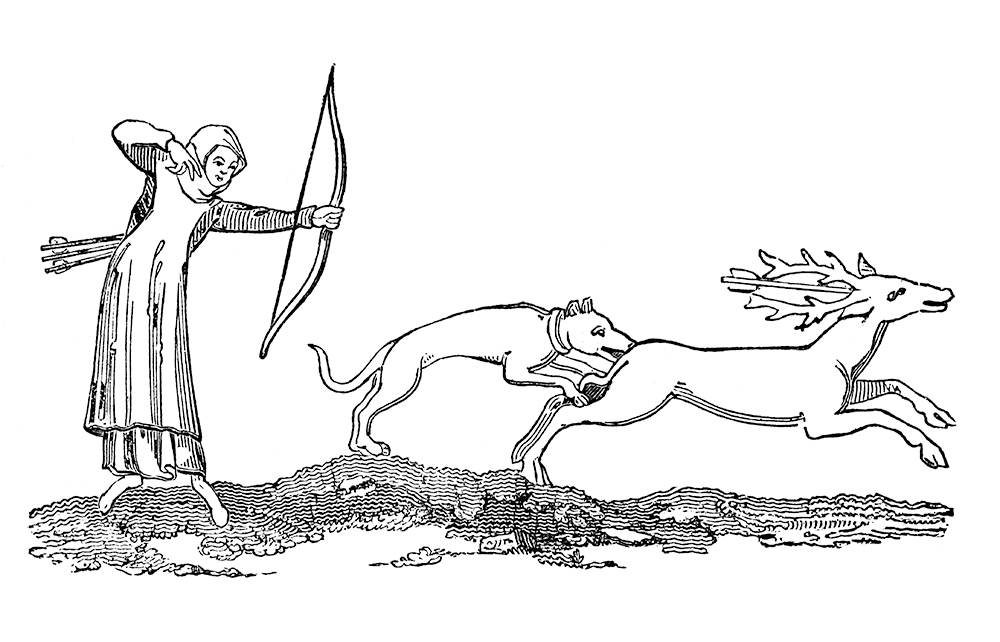In 1448, Margaret Paston, a wife and mother in her twenties, wrote to her husband John urgently requesting more weapons: she needed crossbows, poleaxes, windlasses and jacks. In John’s absence, a local lord was trying to take over Gresham, their property in Norfolk, and was mounting a violent siege of the manor house. Margaret was leading the defence. She was multi-tasking, however. In the same letter she also asks John to send some almonds and sugar, as well as woollen cloth for gowns for their young sons and broadcloth for a hood for herself.
The missive survives as part of the Paston letters, the largest extant set of medieval correspondence relating to a single family in England. The Pastons were not nobility: they were up-and-coming gentry, social climbers jockeying for position in the tumultuous century of the Wars of the Roses. The letters are well-known, and books such as Helen Castor’s Blood and Roses have brought the whole family to life for us. Diane Watt’s God’s Own Gentlewoman does something different. It is a rich and accessible biography of Margaret Paston, for decades the matriarch of the family and the author (via dictation) of more letters in the collection than anyone else.
The Paston men were often away from their East Anglian lands, leaving the women to hold the fort while they politicked in London, hung around court or went off to fight elsewhere. The women therefore had all kinds of responsibilities. While some passages of Margaret’s letters deal with traditional concerns such as childbirth, clothing and arranging marriages, the correspondence also demonstrate just how varied those experiences and responsibilities actually were. Margaret – and the other Paston women – write about politics, siege warfare, fishponds, royal visits, crime, contested wills and inheritance. Watt takes a particular letter as a starting point for each chapter, then expands the topic through multiple historical and literary texts. We hear in brief about other fascinating medieval women, such as Cecilia of Oxford, a 14th-century surgeon to the queen, and Alice Chaucer, Duchess of Suffolk and granddaughter of the poet, who was a formidable adversary of the Pastons in their many property disputes.
The family’s involvement in local politics had national dimensions, as the Wars of the Roses played out via regional conflicts throughout the mid-15th century. The letters also remind us of the international scope of medieval life. Margaret was robbed in 1465 by men working for Alice Chaucer and her son, claiming royal backing, at a time when John Paston was in prison in London. The items stolen included threads from Venice and Genoa, Holland cloth and an ivory comb. Watt gives us a sense of the fabric of late medieval life: candles imported from Russia; footwear purchased from ‘the hosier with the crooked back’ at Black Friars; chess and backgammon sets and the new fashion for playing cards.
For most of the book we see the world through the eyes of Margaret. But she is not idealised; nor are the other Paston matriarchs. Indeed, their appalling behaviour is all too apparent. Margaret’s mother-in-law, Agnes, treated her daughter Elizabeth brutally. When Elizabeth disagreed with her mother in the matter of her marriage, Agnes locked her up and beat her regularly. Margaret, too, fell out with her daughter Margery after the girl fell in love with a family servant, Richard Calle. The two married secretly and then told their families, whereupon Margaret and Agnes tried to persuade the Bishop of Norwich to declare the union void. But he insisted on speaking to Margery, and the marriage stood – so Margaret disowned her daughter.
In both these cases, the financial stability and reputation of the family were considered far more important by the senior members than the happiness of the Paston daughters, who were expected to do as they were told in the marriage market. Yet both young women successfully refused, and did end up choosing their own futures.
God’s Own Gentlewoman does not aim to be a comprehensive biography. Rather, it is a series of snapshots of Margaret, and of medieval women generally. Her life was not ‘typical’ – whose is? – but her experiences shine a light on the sort of things expected of people like her. In the past few years there has been a spate of books about medieval women, many of them novels, perhaps owing to the limited surviving evidence. Their popularity is testament to readers’ interest in medieval women’s lives, which were so much more varied than we tend to assume.
Watt weaves her own life into the Paston story. She reflects throughout on her position and perspective, and about how researching these Norfolk matriarchs connected to her understanding of generations of women in her family. To write the book, she made several pilgrimages to East Anglia to trace Margaret’s movements. In 1985, Richard Holmes published his influential Footsteps: Adventures of a Romantic Biographer, which is both a biography of the Romantic poets and an account of his journeys in their wake. Watt aims to do something similar, and describes episodes in which she wanders through Norfolk, seeing what remains and what can only now be imagined of the places that mattered to Margaret. These scenes are powerful reminders of how the medieval landscape pierces our contemporary moment. It would have added a valuable dimension if the publishers had included photographs of the sites.
Certain passages in the letters bring Margaret vividly to life. To her husband she writes: ‘I would rather you were at home… than have a new gown, even it were of scarlet.’ Other details relate to her own fabulous self-fashioning, notably when she coins the word ‘captainess’ when defending the Paston properties from the predations of aristocrats. Yet others are thoughtful and analytical. There is a striking moment when Margaret, describing the social unrest, writes that the people ‘act as if they were expecting a new world’.
New worlds rarely come, and the world of the Pastons was in some ways not so different from our own. Margaret’s captivating story reveals a line of impressive women who held their own in a complex world of intrigue and politics, fashion and business, violence and love.







Comments